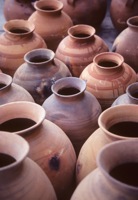Difference between revisions of "Clay"
(Created page with 'File:lighterstill.jpgright|frame ==Origin== [http://nordan.daynal.org/wiki/index.php?title=English#ca._1100-1500_.09THE_MIDDLE_ENGLISH_PERIOD Middle ...') |
m (Text replacement - "http://" to "https://") |
||
| (One intermediate revision by the same user not shown) | |||
| Line 2: | Line 2: | ||
==Origin== | ==Origin== | ||
| − | [ | + | [https://nordan.daynal.org/wiki/index.php?title=English#ca._1100-1500_.09THE_MIDDLE_ENGLISH_PERIOD Middle English], from [https://nordan.daynal.org/wiki/index.php?title=English#ca._600-1100.09THE_OLD_ENGLISH.2C_OR_ANGLO-SAXON_PERIOD Old English] clǣg; akin to Old High German klīwa bran, [[Latin]] gluten glue, Middle Greek glia |
| − | *[ | + | *[https://en.wikipedia.org/wiki/12th_century before 12th Century] |
==Definitions== | ==Definitions== | ||
*1a : an [[earth]]y [[material]] that is plastic when moist but hard when fired, that is [[composed]] mainly of fine [[particles]] of hydrous aluminum silicates and other minerals, and that is used for brick, tile, and pottery; specifically : [[soil]] composed chiefly of this material having particles less than a specified size | *1a : an [[earth]]y [[material]] that is plastic when moist but hard when fired, that is [[composed]] mainly of fine [[particles]] of hydrous aluminum silicates and other minerals, and that is used for brick, tile, and pottery; specifically : [[soil]] composed chiefly of this material having particles less than a specified size | ||
| Line 11: | Line 11: | ||
:c : fundamental [[nature]] or [[character]] <the common clay> | :c : fundamental [[nature]] or [[character]] <the common clay> | ||
==Description== | ==Description== | ||
| − | '''Clay''' (pronounced /ˌklei/) is a naturally occurring [ | + | '''Clay''' (pronounced /ˌklei/) is a naturally occurring [https://en.wikipedia.org/wiki/Aluminium_silicate aluminium silicate] composed primarily of fine-grained [https://en.wikipedia.org/wiki/Mineral minerals]. Clay deposits are mostly composed of clay minerals, a subtype of [https://en.wikipedia.org/wiki/Silicate_minerals#Phyllosilicates phyllosilicate minerals], which impart plasticity and harden when fired or dried; they also may contain variable amounts of [[water]] trapped in the mineral [[structure]] by polar [[attraction]]. [https://en.wikipedia.org/wiki/Organic_material Organic materials] which do not impart plasticity may also be a part of clay deposits. |
==Formation== | ==Formation== | ||
| − | Clay minerals are typically formed over long periods of time by the [[gradual]] [[chemical]] weathering of [[rocks]], usually silicate-bearing, by low concentrations of [ | + | Clay minerals are typically formed over long periods of time by the [[gradual]] [[chemical]] weathering of [[rocks]], usually silicate-bearing, by low concentrations of [https://en.wikipedia.org/wiki/Carbonic_acid carbonic acid] and other diluted solvents. These solvents, usually acidic, migrate through the weathering [[rock]] after leaching through upper weathered layers. In addition to the weathering [[process]], some clay minerals are formed by [https://en.wikipedia.org/wiki/Hydrothermal hydrothermal] activity. Clay deposits may be formed in place as residual deposits in [[soil]], but thick deposits usually are formed as the result of a secondary [https://en.wikipedia.org/wiki/Hydrothermal sedimentary] deposition [[process]] after they have been eroded and transported from their [[original]] location of formation. Clay deposits are typically associated with very low energy [https://en.wikipedia.org/wiki/Sedimentary_depositional_environment depositional environments] such as large [[lakes]] and [[marine]] deposits. |
| − | Primary clays, also known as [ | + | Primary clays, also known as [https://en.wikipedia.org/wiki/Kaolinite kaolins], are located at the site of formation. Secondary clay deposits have been moved by [[erosion]] and [[water]] from their primary location.[https://en.wikipedia.org/wiki/Clay] |
[[Category: Earth Science]] | [[Category: Earth Science]] | ||
Latest revision as of 23:41, 12 December 2020
Origin
Middle English, from Old English clǣg; akin to Old High German klīwa bran, Latin gluten glue, Middle Greek glia
Definitions
- 1a : an earthy material that is plastic when moist but hard when fired, that is composed mainly of fine particles of hydrous aluminum silicates and other minerals, and that is used for brick, tile, and pottery; specifically : soil composed chiefly of this material having particles less than a specified size
- b : earth, mud
- 2a : a substance that resembles clay in plasticity and is used for modeling
- b : the human body as distinguished from the spirit
- c : fundamental nature or character <the common clay>
Description
Clay (pronounced /ˌklei/) is a naturally occurring aluminium silicate composed primarily of fine-grained minerals. Clay deposits are mostly composed of clay minerals, a subtype of phyllosilicate minerals, which impart plasticity and harden when fired or dried; they also may contain variable amounts of water trapped in the mineral structure by polar attraction. Organic materials which do not impart plasticity may also be a part of clay deposits.
Formation
Clay minerals are typically formed over long periods of time by the gradual chemical weathering of rocks, usually silicate-bearing, by low concentrations of carbonic acid and other diluted solvents. These solvents, usually acidic, migrate through the weathering rock after leaching through upper weathered layers. In addition to the weathering process, some clay minerals are formed by hydrothermal activity. Clay deposits may be formed in place as residual deposits in soil, but thick deposits usually are formed as the result of a secondary sedimentary deposition process after they have been eroded and transported from their original location of formation. Clay deposits are typically associated with very low energy depositional environments such as large lakes and marine deposits.
Primary clays, also known as kaolins, are located at the site of formation. Secondary clay deposits have been moved by erosion and water from their primary location.[1]
